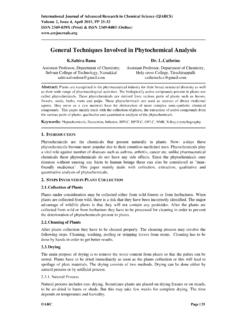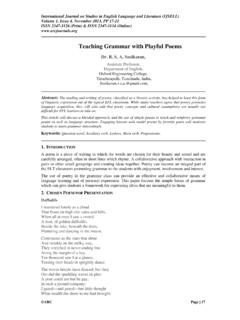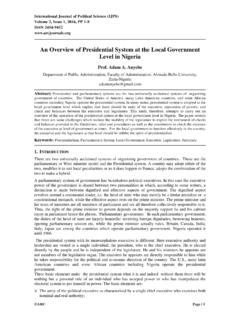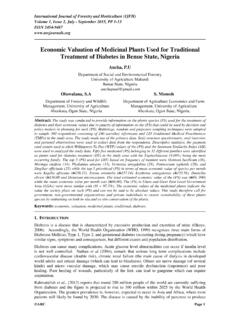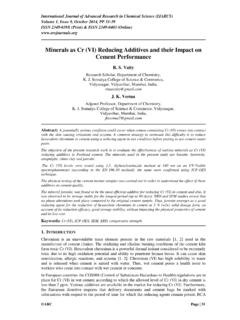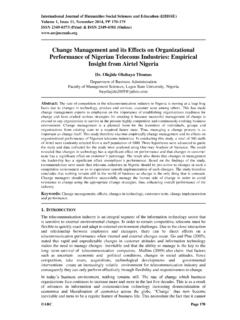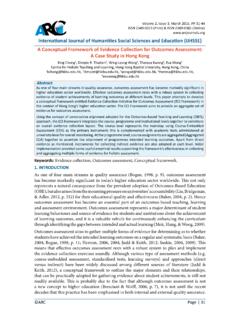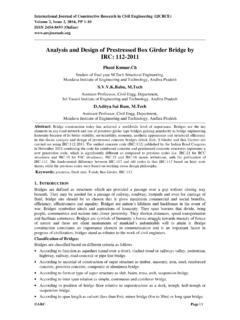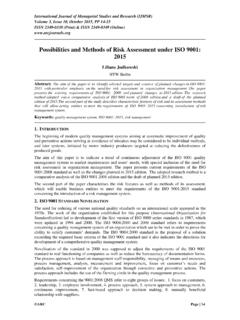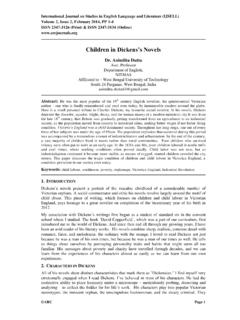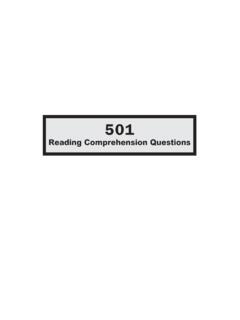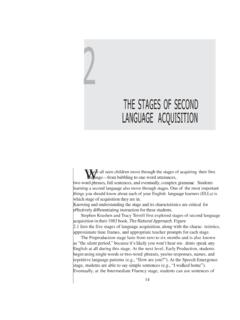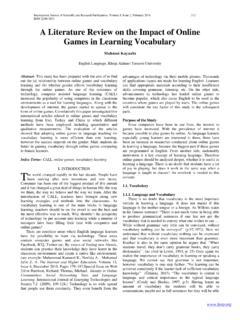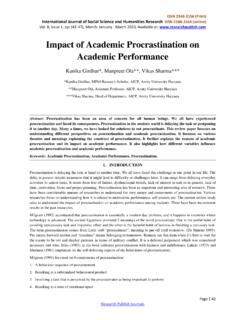Transcription of Speaking Difficulties Encountered by Young EFL Learners
1 International Journal on Studies in English Language and Literature (IJSELL) Volume 2, Issue 6, June2014, PP 22-30 ISSN 2347-3126 (Print) & ISSN 2347-3134 (Online) ARC Page | 22 Speaking Difficulties Encountered by Young EFL Learners Samira Al Hosni TEFL Supervisor and Instructor Ministry of Education. Oman Abstract: Speaking is the active use of language to express meaning, andfor Young Learners , the spoken language is the medium through which a new language is Encountered , understood, practiced, and learnt. Rather than oral skills being simply one aspect of learning language, the spoken form in the Young learner s classroom acts as the prime source of language learning. However, Speaking problems can be major challenges to effective foreign language learning and communication.
2 English as foreign language (EFL) Learners , no matter how much they know about the English language, still face many Speaking studies have indicated that oral language development has largely been neglected in the classroom, and most of the time, oral language in the classroom is used more by teachers than by students. However, oral language, even as used by the teacher, hardly ever functions as a means for students to gain knowledge and explore ideas. To develop the knowledge to deal with oral communication problems in an EFL context, researchers first need to know the real nature of those problems and the circumstances in which problems are constructed. Keywords: Speaking , Speaking Difficulties ,language acquisition, Oral language learning 1. INTRODUCTION According to the Ministry of Education in Oman (1996), basic education aims to make the learner gain necessary skills for life by developing his/her communication skills, self- learning, and ability to use critical thinking to deal with science and modern technology (Al Abri, 2008).
3 Obviously, it is necessary to develop communication skills. English oral communication skills are part of this skill set, and thus, students should be supported to gain these skills. Learners of English in Oman often do not have opportunities to speak English outside the classroom, and for many of them, the course book is the only place where they meet English (Al Zedjali, 2009). Although Speaking is considered a main language skill that students should improve, it has been widely noticed that they face many Difficulties in Speaking English. This study aims to find out what Speaking Difficulties are Encountered by grade 5 students in basic education schools in Oman. It also aims to find out the main factors that contribute to the existence of these results of this study can help the Ministry of Education, the EFL teachers, the curriculum designers, and the designers of assessment tools to understand the reasons why our Young Learners in grade 5 basic education schools find it difficult to speak in English, and consequently, their plans for change and improvement of the students Speaking skill can produce more effective results when these factors are considered.
4 2. REVIEW OF LITERATURE Teaching of Speaking The use of English as a second language (ESL) or foreign language (EFL) in oral communication is, withouta doubt, one of the most common but highly complex activities necessary to be considered when teaching the English language especially because we live at a time where the ability to speak English fluently has become a must, especially who want to advance in certain fields of human endeavor (Al-Sibai,2004, ). The focus of teaching Speaking , of course, is to improve the oral production of the students. Therefore, language teaching activities in the classroom should aim at maximising individual language use (Haozhang, 1997). In the past, oral communication instruction was neglected Samira Al Hosni International Journal on Studies in English Language and Literature (IJSELL) Page | 23 because of the misconception that oral communication competence develops naturally over time and that the cognitive skills involved in writing automatically transfer to analogous oral communication skills(Chaney,1998).
5 However, Ur (1996) considered Speaking as the most important skill among four skills (listening, Speaking , reading, and writing) because people who know a language are referred to as speakers of that language. This indicates that using a language is more important than just knowing about it because there is no point knowing a lot about language if you can t use it (Scrivener,2005, ). Oral Language Acquisition Oral language acquisition is a natural process for children. It occurs almost without effort. The ability to speak grows with age, but it does not mean that such growth will automatically lead to perfection. To speak in more effective ways requires particular attention and constant practice (Zhang et al., 1995). Speaking fluency appears to develop with increased exposure to second language(L2) input (Al-Sibai, 2004). Input refers to the language data which the learner is exposed to (Zhang, 2009).
6 Although it is widely recognised that input is very essential for language acquisition, it is not sufficient if not followed by interaction and output (the language a learner produces)because the processing of comprehension is different from the processing of production, and the ability to understand the meaning conveyed by sentences differs from the ability to use a linguistic system to express meaning. When input is negotiated and Learners produce output in interaction, they selectively take in portions of comprehensible input and choose a correct linguistic form to express themselves. This process makes it possible for the Learners to internalise what they have learned and experienced (Swain, 1985, as cited in Zhang, 2009). Oral Language Learning For language learning to take place, there are four conditions that should exist, and they are the exposure, opportunities to use the language, motivation, and instruction.
7 Learners need chances to say what they think or feel and to experiment in a supportive atmosphere using language they have heard or seen without feeling threatened (Willis,1996, ). A fact that is highlighted by second language research is that progress does not occur when people make a conscious effort to learn. Progress occurs as a result of spontaneous, subconscious mechanisms, which are activated when Learners are involved in communication with the second language. The subconscious element demands a new range of activities, where Learners are focused not on the language itself but on the communication of meaning (Littlewood, 1984). Harmer (1982) also argued that in a communicative task, the students attention should be focused on the content of what they are saying, rather than the form. They should use a wide variety of language. According to Ellis (2003), this can be done by involving Learners in performing two types of communicative tasks: focused communicative tasks and unfocused communicative tasks.
8 Both of these tasks seek to engage Learners in using language pragmatically rather than displaying language. They seek to develop language proficiency through communication. Through communication Learners can integrate separate structures into a creative system for expressing meaning (Littlewood,1984, ). Factors that Cause Speaking Difficulties to EFL Learners Zhang (2009) argued that Speaking remains the most difficult skill to master for the majority of English Learners , and they are still incompetent in communicating orally in to Ur (1996), there are many factors that cause difficulty in Speaking , and they areas follows: Students are worried about making mistakes, fearful of criticism, or simply shy. to say. Students have no motive to express themselves. or uneven participation. Only one participant can talk at a time because of large classes and the tendency of some Learners to dominate, while others speak very little or not at all.
9 Use. Learners who share the same mother tongue tend to use it because it is easier and because Learners feel less exposed if they are Speaking their mother tongue. Speaking Difficulties Encountered by Young EFLL earners International Journal on Studies in English Language and Literature (IJSELL) Page | 24 In addition, Rababa h (2005) pointed out that there are many factors that cause Difficulties in Speaking English among EFL Learners . Some of these factors are related to the Learners themselves, the teaching strategies,the curriculum, and the environment. For example, many Learners lack thenecessary vocabulary to get their meaning across, and consequently, they cannot keep the interaction strategic competence and communication competence can be another reason as well for not being able to keep the interaction going. Some Learners also lack the motivation to speak English.
10 They do not see a real need to learn or speak English. Actually motivation is the crucial force which determines whether a learner embarks in a task at all, how much energy he devotes to it, and how long he preservers (Littlewood, 1984, ). The development of communicative skills can only take place if Learners have the motivation and opportunity to express their own identity and relate with the people around them (Littlewood, 1981). Teaching strategies also contribute to this problem as they are inadequate, and they do not put emphasis on Speaking , which results in a meagre development of this skill. Besides, vocabulary items are taught in isolation, and listening materials are not used by the majority of schoolteachers because of the large number of teachers compared with the number of cassettes available. Teacher-training programs were found to be not very successful in changing the teachers methodology (Rababa ah,2005).
